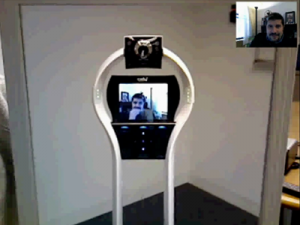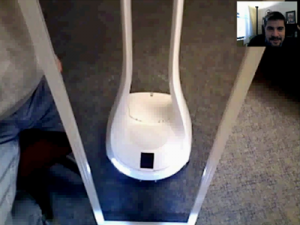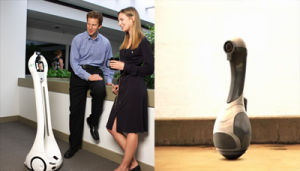Specs
In designing the VGo, Tim and the team focused on a very simple concept that came with every use of the VGo – they knew there were going to have the smartest sensor embedded in the system – the pilot. By leveraging the intelligence of the pilot, the system could be simplified which would in turn offer a lower cost system.
Audio
On the VGo are four mics – two on each side of the head (by the indicator headlights), which provide a 360 degree sense of sound around the VGo.

Wow - what a handsome devil!
Video
The video is a 6 inch LCD inside the head and the camera is above the screen which allows for 180 degrees of tilt (up/down). The head camera provides approximately a 60 degree point-of-view width. The two way video itself is something the team worked on – delivering rich standard video definition for both the pilot and the participants. The codec conforms to today’s H.264 standard, consistent with almost all compressed video out there today.
Sensors
 Additionally, the VGo has a front bumper system, which allows for an amusing experience when one hits something (the team set up a popup that harkens back to the Kapows! of yesteryear). In addition, it has multiple IR sensors to determine if there are any obstacles that might harm the head of the VGo (read: tabletop) or obstacles that might be blocking its path. Users are warned with a simple pop up message.
Additionally, the VGo has a front bumper system, which allows for an amusing experience when one hits something (the team set up a popup that harkens back to the Kapows! of yesteryear). In addition, it has multiple IR sensors to determine if there are any obstacles that might harm the head of the VGo (read: tabletop) or obstacles that might be blocking its path. Users are warned with a simple pop up message.

Check out that bass in the base
Additional Perks
Two of my favorite features were the text-to-speech voice processor – which allowed my VGo to speak if my mic was not working or if I was more comfortable letting my VGo say something rather than me and the auto-docking feature – where the VGo, within a certain radius of the charging station, would park itself for charging.
My experience in using the VGo I will summarize in a separate post, but I will say it is the most professional interfaces I have seen in the market to date, and one that most people will enjoy using.
From Idea to Manufacturable Product
One of the questions that people always ask is “why aren’t the robots here yet?”. I have to point out the challenges that exist in making any hardware product that is stable, bug-free and meets an insane number of legal requirements (e.g., UL). In VGo’s case, it took three months to build out a viable prototype to be able to show to investors; then eighteen months to customize the electronics, formalize the ID and tool up, handle the manufacturing issues and then deal with any of the bug issues that come with the build of any mass produced product.
In the same time, software development on the server architecture (VGo offers a chat client similar to Skype for connection) as well as the client software.
One of VGos greatest assets was their team’s experience in bringing products to market. By having two excellent robotists from iRobot who were well versed in manufacturing mass market products, as well as his and others experiences, they were able to overstep some of the typical startup hiccups that normally occur.
VGo Communications, Not VGo Robotics
Tim and I discussed his vision which was more focused on enabling communications, not robotics. As he said, the name of the company is VGo Communications, not VGo Robots. And he spent a great deal of time schooling people, customers, and investors on this concept. He sees the challenges all of the players in the RPS space will see – across the enterprise, schools, government, etcetera. He sees the RPS space as quite similar to the early days as cellphone – on the cusp of a similar explosion of the market.

Are we seeing the future?
RPS will be part of the ecosystem of the communications market – not killing off products, but maybe supplanting some and augmenting others. He sees a future where RPSes will be in everyone’s home – doing simple things (I liken his vision to SyFy’s Sergio). For him, the VGo is solving the 80% problem – the other 20% will come as the market requires it (like manipulators and variable height). He believes these options will come, but they need to be more market driven than just research.
As I drove around the office, I got to meet more of the VGo staff and learn that their strategy of working with value-added resellers is bearing them excellent fruit – both in terms of customer feedback and sales.
John Nye, VG0’s Head of Business Development told me of various people using the VGos in their everyday work – companies such as Palamar Health and Orbitz as well as smaller companies such as DYN and Ratepoint. The use cases they were discovering included the basic remote presence on servers at a collocation facility (DYN) and remote management for a sales manager (Ratepoint) managing his inside sales team while he handles the higher-touch clients on the road. In the sales case, the company reported a 30% increase in their sales performance in the first month of using the VGo.
While they did not give me numbers of units sold, they said they had sold “hundreds” and I saw in their offices boxes of VGos ready for shipping to clients. And with their VAR partners, getting more repeatable experiences with types of clients and beginning to see repeat business through their channels – even getting market validation to increase the price of their unit to closer to $6K, from the previously list price of $5K.
What’s the Future?
When I asked Tim about what’s next – and aside from talking about a Mac platform or a smartphone interface – he said what Trevor said: they are currently listening to the customers – hearing their feedback as to what they want. In the past eighteen months, they have collected a fair amount of feedback and are planning how they will extend their offering. He said they have not heard the dreaded “I am not going to buy it because it does not have…” which leads them to believe they are on the right path.
Yes there are potential competitors – we talked a bit about the iRobot newest foray with the AVA, but Tom Ryden pointed out although they do not have a product for sale, their activities help create awareness and validate the market and the application for all vendors. I learned that AVA is iRobot’s fifth iteration into the remote presence space, and I too look forward to see what comes of their investigations.

Thanks for visiting VGo Communications!
The VGo team’s next set of work will be in taking all of this knowledge from their customers and creating the requirements that will drive offerings for specialized vertical markets.
They always ask the questions: what’s the application for this feature? What is the use case? Now thats a strong product focus.





